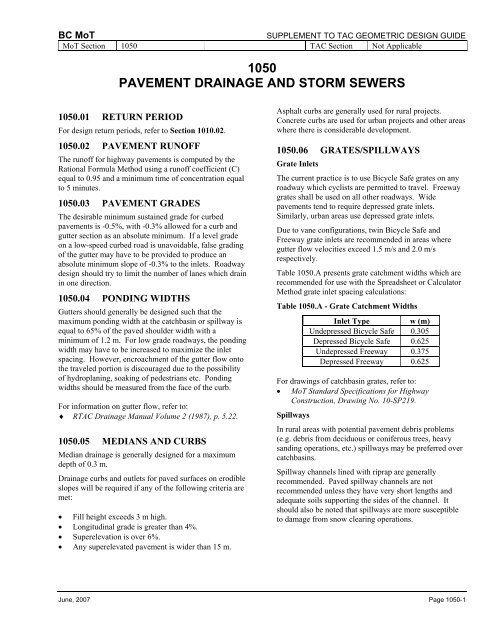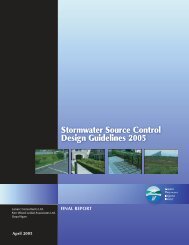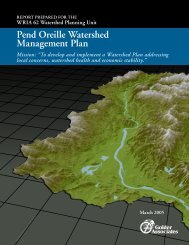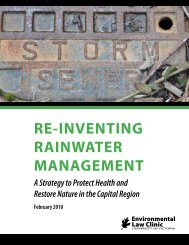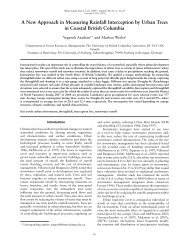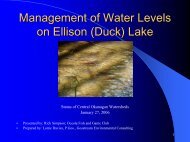1000 Hydraulics Chapter - Ministry of Transportation
1000 Hydraulics Chapter - Ministry of Transportation
1000 Hydraulics Chapter - Ministry of Transportation
Create successful ePaper yourself
Turn your PDF publications into a flip-book with our unique Google optimized e-Paper software.
BC MoT<br />
SUPPLEMENT TO TAC GEOMETRIC DESIGN GUIDE<br />
MoT Section 1050 TAC Section Not Applicable<br />
1050<br />
PAVEMENT DRAINAGE AND STORM SEWERS<br />
1050.01 RETURN PERIOD<br />
For design return periods, refer to Section 1010.02.<br />
1050.02 PAVEMENT RUNOFF<br />
The run<strong>of</strong>f for highway pavements is computed by the<br />
Rational Formula Method using a run<strong>of</strong>f coefficient (C)<br />
equal to 0.95 and a minimum time <strong>of</strong> concentration equal<br />
to 5 minutes.<br />
1050.03 PAVEMENT GRADES<br />
The desirable minimum sustained grade for curbed<br />
pavements is -0.5%, with -0.3% allowed for a curb and<br />
gutter section as an absolute minimum. If a level grade<br />
on a low-speed curbed road is unavoidable, false grading<br />
<strong>of</strong> the gutter may have to be provided to produce an<br />
absolute minimum slope <strong>of</strong> -0.3% to the inlets. Roadway<br />
design should try to limit the number <strong>of</strong> lanes which drain<br />
in one direction.<br />
1050.04 PONDING WIDTHS<br />
Gutters should generally be designed such that the<br />
maximum ponding width at the catchbasin or spillway is<br />
equal to 65% <strong>of</strong> the paved shoulder width with a<br />
minimum <strong>of</strong> 1.2 m. For low grade roadways, the ponding<br />
width may have to be increased to maximize the inlet<br />
spacing. However, encroachment <strong>of</strong> the gutter flow onto<br />
the traveled portion is discouraged due to the possibility<br />
<strong>of</strong> hydroplaning, soaking <strong>of</strong> pedestrians etc. Ponding<br />
widths should be measured from the face <strong>of</strong> the curb.<br />
For information on gutter flow, refer to:<br />
♦ RTAC Drainage Manual Volume 2 (1987), p. 5.22.<br />
1050.05 MEDIANS AND CURBS<br />
Median drainage is generally designed for a maximum<br />
depth <strong>of</strong> 0.3 m.<br />
Drainage curbs and outlets for paved surfaces on erodible<br />
slopes will be required if any <strong>of</strong> the following criteria are<br />
met:<br />
• Fill height exceeds 3 m high.<br />
• Longitudinal grade is greater than 4%.<br />
• Superelevation is over 6%.<br />
• Any superelevated pavement is wider than 15 m.<br />
Asphalt curbs are generally used for rural projects.<br />
Concrete curbs are used for urban projects and other areas<br />
where there is considerable development.<br />
1050.06 GRATES/SPILLWAYS<br />
Grate Inlets<br />
The current practice is to use Bicycle Safe grates on any<br />
roadway which cyclists are permitted to travel. Freeway<br />
grates shall be used on all other roadways. Wide<br />
pavements tend to require depressed grate inlets.<br />
Similarly, urban areas use depressed grate inlets.<br />
Due to vane configurations, twin Bicycle Safe and<br />
Freeway grate inlets are recommended in areas where<br />
gutter flow velocities exceed 1.5 m/s and 2.0 m/s<br />
respectively.<br />
Table 1050.A presents grate catchment widths which are<br />
recommended for use with the Spreadsheet or Calculator<br />
Method grate inlet spacing calculations:<br />
Table 1050.A - Grate Catchment Widths<br />
Inlet Type w (m)<br />
Undepressed Bicycle Safe 0.305<br />
Depressed Bicycle Safe 0.625<br />
Undepressed Freeway 0.375<br />
Depressed Freeway 0.625<br />
For drawings <strong>of</strong> catchbasin grates, refer to:<br />
• MoT Standard Specifications for Highway<br />
Construction, Drawing No. 10-SP219.<br />
Spillways<br />
In rural areas with potential pavement debris problems<br />
(e.g. debris from deciduous or coniferous trees, heavy<br />
sanding operations, etc.) spillways may be preferred over<br />
catchbasins.<br />
Spillway channels lined with riprap are generally<br />
recommended. Paved spillway channels are not<br />
recommended unless they have very short lengths and<br />
adequate soils supporting the sides <strong>of</strong> the channel. It<br />
should also be noted that spillways are more susceptible<br />
to damage from snow clearing operations.<br />
June, 2007 Page 1050-1


